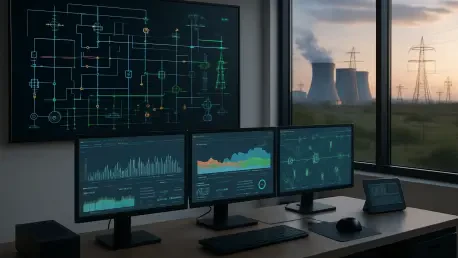In a world where energy demands are skyrocketing and grid reliability is under constant strain, a subtle yet powerful transformation is taking place, driven not by sweeping government mandates but by the ingenuity of private enterprises. Beneath the surface of headline-grabbing topics like renewable energy booms and data center expansions, a quieter revolution is unfolding. Private businesses, ranging from heavy machinery giants to niche service providers, are stepping into roles traditionally held by utility monopolies, leveraging cutting-edge technology to redefine how energy is managed and optimized. This shift is turning energy from a static expense into a dynamic, controllable asset, with commercial and multifamily sectors playing an unexpectedly pivotal role. As these entities adopt sophisticated systems and data-driven strategies, they are not only enhancing their own operations but also bolstering the stability of the broader electrical grid, setting the stage for a more resilient energy future.
The Rise of Commercial Energy Leadership
Transforming Grid Stability Through Business Innovation
The electrical grid, long plagued by unpredictability and strain, is finding an unlikely ally in commercial customers who are emerging as key stabilizers. Unlike residential users whose energy consumption often fluctuates unpredictably, businesses have the capacity to manage their Peak Load Contributions (PLC) with precision. This ability allows them to reduce stress on the grid during critical times. Multifamily communities, once categorized strictly as residential, are now operating more like commercial campuses by integrating advanced energy management tools. Through platforms like Distributed Energy Resource Management Systems (DERMS), these properties are optimizing their energy loads, slashing operational costs, and contributing to grid reliability. This trend represents a significant departure from traditional models, as private entities take on responsibilities that utilities once dominated, using technology to create a more balanced and efficient energy ecosystem that benefits all stakeholders.
Data-Driven Strategies in Multifamily Sectors
Beyond individual businesses, the multifamily sector is carving out a unique space in this energy revolution by harnessing data to drive efficiency. Representing over 17 million American renters, this often-overlooked industry is aggregating its influence to create substantial buying power and access real-time energy insights that utilities have historically struggled to obtain. By adopting tailored supply contracts and smart technologies, multifamily properties are lowering capacity costs and achieving verifiable reductions in carbon emissions. Residents, too, are seeing tangible benefits, gaining access to tools that provide transparency into their usage and environmental impact. This shift transforms their relationship with energy from passive consumption to active engagement, fostering a culture of sustainability. As these communities continue to adopt innovative practices, their role in supporting grid stability grows, proving that private innovation can deliver results where traditional approaches have faltered.
Technology as the Catalyst for Energy Mastery
From Basic Management to Strategic Control
The journey from rudimentary energy management to what can be described as energy mastery is being led by forward-thinking companies that integrate technology into every facet of their operations. A prime example is the evolution seen in the multifamily sector, where service providers are moving beyond simple metering and billing. By incorporating smart systems like O&M Insights, these companies use in-unit devices to monitor consumption and detect issues such as leaks remotely, minimizing disruptions and slashing maintenance costs. This proactive approach not only enhances resident comfort but also provides detailed consumption data that informs better decision-making. The result is a seamless blend of operational efficiency and grid support, as properties reduce their energy footprint while contributing to a more stable energy network. This transition underscores how technology is empowering private players to treat energy as a strategic variable rather than a fixed burden.
Building Resilience Through Decentralized Solutions
Another critical aspect of this technological wave is the emphasis on resilience through decentralized energy solutions. Private businesses are deploying tools that enable community-wide energy optimization, ensuring that disruptions in one area don’t cascade across the grid. These innovations allow commercial and multifamily customers to aggregate their resources, creating micro-networks of efficiency that bolster overall system reliability. The data generated from these efforts offers unprecedented visibility into energy patterns, enabling predictive maintenance and smarter load distribution. This decentralized model stands in stark contrast to the centralized utility frameworks of the past, offering a more adaptable and responsive approach to energy challenges. Residents within these communities also gain a sense of empowerment, as they can monitor and manage their usage in real time, fostering a shared commitment to sustainability. Such advancements highlight the transformative potential of technology when wielded by private innovators focused on long-term grid health.
Charting the Path Forward with Private Expertise
Lessons from a Quiet Energy Shift
Reflecting on the strides made, it becomes clear that private innovation has quietly redefined the energy landscape over recent years. Companies in the commercial and multifamily sectors have taken bold steps to adopt advanced technologies, turning energy from a passive cost into a strategic asset. Their efforts have stabilized the grid in ways that traditional utility models couldn’t, using data and smart systems to optimize usage and reduce waste. Service providers have expanded their reach, integrating sophisticated platforms that enhance both operational efficiency and resident engagement. This under-the-radar movement proves that impactful change doesn’t always require grand policy shifts; sometimes, it emerges from the focused expertise of private players committed to solving real-world problems with practical, tech-driven solutions.
Future Steps for a Sustainable Grid
Looking ahead, the momentum built by these private innovators offers a blueprint for scaling sustainable energy practices. Stakeholders across the energy spectrum should prioritize collaboration, encouraging the adoption of DERMS and similar platforms to amplify grid stability. Investment in real-time data systems will be crucial to anticipate and address load challenges before they escalate. Additionally, expanding resident education programs can further drive engagement, ensuring communities play an active role in energy conservation. Policymakers might consider incentives that reward businesses for their contributions to grid health, creating a virtuous cycle of innovation and reliability. By building on the foundation laid by private expertise, the energy sector can move toward a future where resilience and efficiency are not just aspirations but standard outcomes of a decentralized, technology-driven approach.









